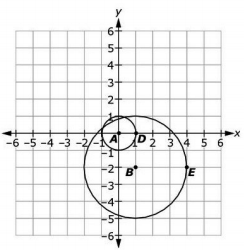Clusters should not be sorted from Major to Supporting and then taught in that order. To do so would strip the coherence of the mathematical ideas and miss the opportunity to enhance the major work of the grade with the supporting clusters.
- Assessment Limits :
Items should not require the student to use the distance or midpoint
formula.Items should not require the student to write an equation of a circle.
Items may require the student to be familiar with using the algebraic
description (x,y) (x+a,y+b) for a translation, and
(x+a,y+b) for a translation, and
(x,y) (kx,ky) for a dilation when given the center of dilation.
(kx,ky) for a dilation when given the center of dilation.Items may require the student to be familiar with the algebraic
description for a 90-degree rotation about the origin,
(x,y) (-y,x), for a 180-degree rotation about the origin,
(-y,x), for a 180-degree rotation about the origin,
(x,y) (-x,-y) , and for a 270-degree rotation about the origin,
(-x,-y) , and for a 270-degree rotation about the origin,
(x,y) (y,-x) .
(y,-x) . Items that use more than one transformation may
ask the student to write a series of algebraic descriptions.Items should not use matrices to describe transformations.
- Calculator :
Neutral
- Clarification :
Students will use a sequence of transformations to prove that circles
are similar.Students will use the measures of different parts of a circle to
determine similarity. - Stimulus Attributes :
Circles should not be given in equation form.
Items may be set in a real-world or mathematical context. - Response Attributes :
Items may require the student to use or choose the correct unit of
measure
- Test Item #: Sample Item 1
- Question:
Circle A has a center at the origin and a point D located on the circle at (1,0). Circle B has a center at (1,-2) and a point E located on the circle at (4,-2).

Logan performs two transformations on circle A to show that circle A is similar to circle B.
He first dilates the circle with the center of dilation at the origin and then translates the new circle.
What are the algebraic descriptions of the two transformations?
- Difficulty: N/A
- Type: EE: Equation Editor
Related Courses
Related Access Points
Related Resources
Formative Assessments
Lesson Plans
Perspectives Video: Professional/Enthusiast
MFAS Formative Assessments
Students are given two circles with different radius lengths and are asked to prove that the circles are similar.
Students are given two circles with different radii and are asked to prove that the circles are similar.







